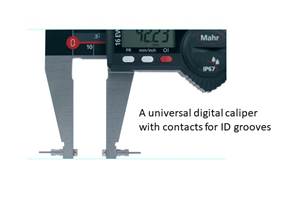Machine Compensation
Ever since electronics first made their way onto machine tools, machine builders and users have tried to achieve some level of "automatic" process control. Certain causes of dimensional variation in machined parts—tool wear, for instance—occur gradually.
Share





.png;maxWidth=45)
DMG MORI - Cincinnati
Featured Content
View More
Takumi USA
Featured Content
View More


ECi Software Solutions, Inc.
Featured Content
View More
Ever since electronics first made their way onto machine tools, machine builders and users have tried to achieve some level of "automatic" process control.
Certain causes of dimensional variation in machined parts—tool wear, for instance—occur gradually. Measuring parts for variation provides a means to efficiently adjust the machine's position settings, to "compensate" for tool wear and other changes.
In the first use of electronics for compensation, parts were gaged by hand, then the operator would press a button on a stepper control attached to the machine tool. One button moved the machine a fixed amount in one direction, while another moved it the same amount in the opposite direction.
The next generation, which integrated electronic gages, took the concept further with automatic feedback control. When the gage sensed that a part had reached or exceeded an approach tolerance, it would send a signal to the machine's controller to compensate. Again, the compensation was a fixed amount each time, and this was known as incremental compensation.
As microprocessors and computers were incorporated into both gaging and machine tools, the simplicity of incremental compensation was replaced by the sophistication of absolute compensation, in which the machine's position is adjusted by the exact amount that is optimum for the process. If desired, compensation can be triggered when part dimensions are drifting just a little bit off nominal, rather than waiting for them to approach tolerance limits.
Computers or microprocessors run algorithms that determine the present level of the process, and look for trends, steps, or other statistical features. While there are a number of different statistical schemes, all use size data from a number of consecutively machined workpieces to establish the current level of the process. A popular, basic scheme is to simply take the average size of the most recent parts. Averaging a large number of parts tends to minimize the influence of normal part-to-part variation, and reduces the number of compensations performed.
Small sample lots, on the other hand, allow the machine to respond faster to process changes.
There are two basic hardware options for modern, automated machine tool compensation. Microprocessor-based CNC/gage interfaces accept input from a variety of electronic gages and gaging amplifiers, and communicate with the CNC via RS232. These are usually panel-mount devices that are pre-programmed to perform a wide range of standard gaging/control actions, with integral keypads that allow users to set approach and tolerance limits, select algorithms, define actions, and so on. The second option is a gaging computer, which offers higher-level capabilities to store or modify algorithms, analyze and utilize data simultaneously from a larger number of inputs, program more complex actions, and store and communicate data. They can be readily interfaced with most modern CNCs and other production equipment.
For example, a large agricultural equipment manufacturer uses a gaging computer to maintain control over gear blank production in fully automated workcells. A robot loads a part into an NC lathe, then removes the half-turned part, turns it around, and loads it into another lathe, which turns the other half. The robot then places the part on an automated gage that measures several ID and OD dimensions. After gaging, the robot stacks the parts on pallets.
All gage functions are controlled by the gaging computer, which allows the manufacturer to switch instantly between eight different part numbers. The computer compensates the lathes based
on the average deviation from the three most recent parts, and shuts down the cell instantly should any dimension fall out of tolerance. The computer also accepts data from temperature sensors in the gage, and performs additional machine compensation for thermal influences.
The use of gages for automatic machine compensation can improve overall quality and productivity, reduce scrap, and minimize manpower requirements. It should be seriously considered for all long-running automated or semi-automated applications where dimensions must be maintained within close tolerances.
Related Content
Choosing the Correct Gage Type for Groove Inspection
Grooves play a critical functional role for seal rings and retainer rings, so good gaging practices are a must.
Read MoreHow to Calibrate Gages and Certify Calibration Programs
Tips for establishing and maintaining a regular gage calibration program.
Read More6 Machine Shop Essentials to Stay Competitive
If you want to streamline production and be competitive in the industry, you will need far more than a standard three-axis CNC mill or two-axis CNC lathe and a few measuring tools.
Read MoreRethink Quality Control to Increase Productivity, Decrease Scrap
Verifying parts is essential to documenting quality, and there are a few best practices that can make the quality control process more efficient.
Read MoreRead Next
5 Rules of Thumb for Buying CNC Machine Tools
Use these tips to carefully plan your machine tool purchases and to avoid regretting your decision later.
Read MoreRegistration Now Open for the Precision Machining Technology Show (PMTS) 2025
The precision machining industry’s premier event returns to Cleveland, OH, April 1-3.
Read MoreSetting Up the Building Blocks for a Digital Factory
Woodward Inc. spent over a year developing an API to connect machines to its digital factory. Caron Engineering’s MiConnect has cut most of this process while also granting the shop greater access to machine information.
Read More





















.png;maxWidth=150)


.png;maxWidth=300;quality=90)


















